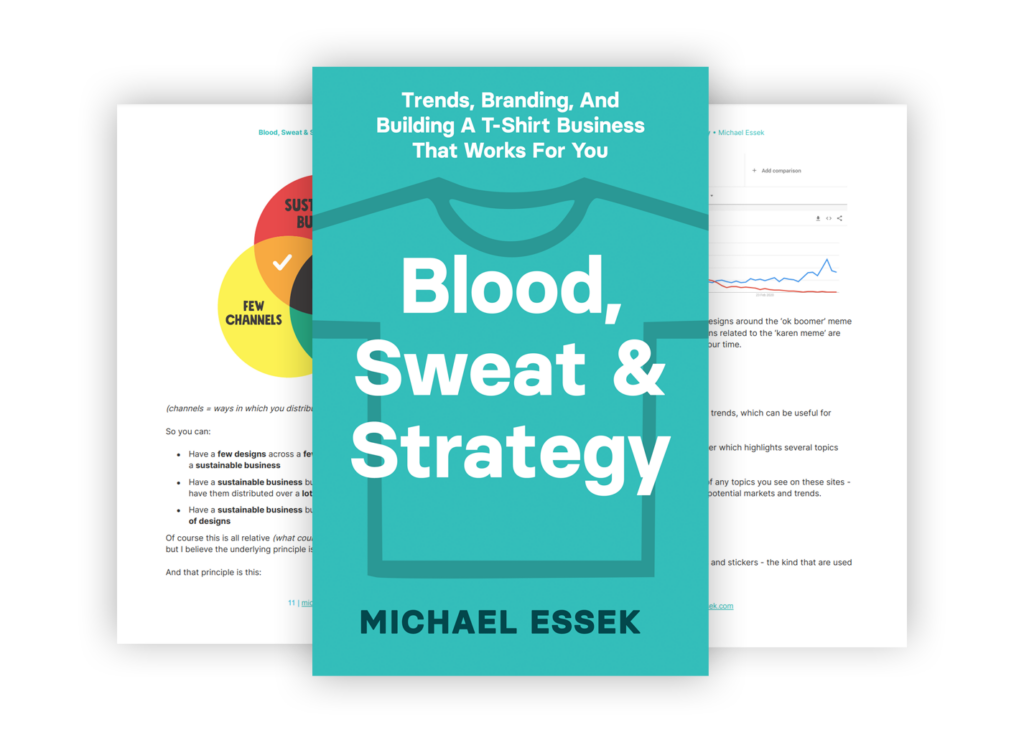4 Hard Things To Do (For Designers Who Want To Grow Fast)
by Michael Essek · Updated: March 28, 2023Have you noticed that we all gravitate towards things that are easy?
Short cuts, tactics, tricks, hacks.
Everybody is looking for the easiest way to achieve anything.
So here’s a crazy idea for you: don’t do that.
Instead, look for the hard things.
For example – what is the hardest thing you could be doing right now?
What are those things that you don’t want to do, that are challenging and painful – but that you know would have a big impact on your business if you did them, or got better at them?
You may not know what those are for you right now – but if you’re trying to make a living from your art – I have a few suggestions for ‘hard things’ you might want to consider…
1. Increase Your Output
If you’re currently producing (𝑥) designs a month, aim to triple or quadruple it.
What would you have to do in order to achieve that?
And how about if you stuck to that level of output for 3 months, or 6 months, or a year?
In my own business, things really took off when I committed to hitting certain design targets every week.
I forced myself to list out 40 ideas a week and commit to turning them into finished designs, whether I thought they were great ideas or not. I had a target, and I was committed to hitting it.
Here’s what happens when you do this:
- You get better, faster. If you practice the guitar one day each month, it’s going to take you a while to master it. But if you practice everyday, you increase your learning by 30x, and drastically shorten the time it takes to become proficient. Same thing with increasing creative output. More designs means more work, which means faster improvements through more experience. It’s like taking a crash course over a few weeks, instead of doing a 3 year, part time night school class.
- When you do something a lot, you notice patterns. Like why you are drawn to certain topics or ideas. Why you dislike having to create in a certain style. Noticing these patterns helps you recognise problems and solve them. For example – I quickly noticed that I was skipping over creating some great ideas because I didn’t have the illustration ability to do them justice. Solution: I hired a freelance designer, and I was then able to create a wider variety of designs, and hit ideas and markets not previously open to me.
- More output means more designs – meaning more chances of making sales, which should mean more profit (all else being equal).
Warning: If your designs are not great (for example – you’re not making regular sales right now) – then I wouldn’t recommend blindly increasing output.
It may help you improve your design ability and your proficiency – but creating more bad designs isn’t likely to move the sales needle.
In fact, if your designs have real problems (eg. lack of audience, no understanding of your market) – then even 100x-ing your output won’t help – and could just leave you in a deeper hole, more frustrated than before. First make sure you have regular sales coming in – then increase your output.
Final thought on this: Another way of looking at increasing output is to challenge yourself to increase the number of designs you do around any given topic or market.
So if you usually create just one single design around a new topic or trend – next time make it a rule that you do at least 3 or 4 (or more) different designs for that subject. And I don’t just mean variations on the design – I mean totally new concepts each time. That’s going to ‘fatten your niches’ (hat tip: Ken Reil) – whilst making you better, faster and more effective.
2. Submit Your Work (to relevant entities who can help you get where you want to be.)
I lived for many years under the enjoyable illusion that once I started putting my work up on the internet, it would almost immediately be seen by lots of people and I’d reap the rewards.
This. is. not. true.
Yes, organic traffic exists, and yes there are ways to get eyeballs on your designs for free. But free traffic is a fickle master – it is easy come and easy go.
If you want to grow a sustainable business that doesn’t rise and fall depending on which website or marketplace updated their algorithm this week – you need to do something most people won’t: go out there and force people to see your work.
And I don’t mean posting on social media – because unless you have a significant following already, that is not going to help.
Posting on social media is an attempt to reach potential customers directly – and while that’s all well and good, it’s a long slog to get to any kind of meaningful, recurring income. Plus, everybody is doing that – including people and businesses with deeper pockets than you.
So instead – go after (and submit your work to) the businesses who serve your ideal customers.
Some examples:
- Submission based T-Shirt sites (Shirt-a-day sites like Yetee, TeeFury, or places like Threadless).
- Blogs and communities related to your target market.
- Instagram accounts or YouTubers with lots of followers (again, related to your target market).
- Book publishers (who have published stuff related to your target market).
- Licensing Agents. (especially those who represent similar design styles)
- Manufacturers and Retailers (who serve your target market).
In other words – which companies are already serving your target market, and how can you get in front of them?
3. Make awesome stuff, give it away for free
If you do want to grow an audience of end-users who are likely buy your stuff, there’s really only one way to do it.
You give people something that they value (usually for free) – and they ‘follow’ you, subscribe, give you their email address, etc.
This is what social media is all about (assuming you aren’t just doing it for fun).
You post cool stuff, and people can look at it for free. They get some enjoyment, some pleasure out of it. It makes them laugh, or think, or helps them learn something.
Because they like it, they want more of it – so they’re going to follow you.
And that’s how you land a ‘follower’ (or subscriber, or fan).
In my opinion, blindly posting your designs on social media is a lame way to grow a following – so here are some other things you can ‘give away’ that potential customers might like:
- backgrounds / wallpapers for phones or desktop
- emotes, emojis or sticker packs
- royalty free illustration sets
- downloads, worksheets, ebooks, printables
- custom artwork (maybe not for free – but at competitive prices)
These tactics will help grow your audience MUCH faster than just ‘posting’ on social media…no matter how great your art is.
4. Go ‘full immersion’ into your market
Newcomers to selling their art online will often spread themselves thin across lots of different niches, markets or subjects.
Like butter scraped over too much bread.
There are of course benefits to trying out different ‘niches’ – but I’ve found that I get the best results when I’m creating around a topic or market that I have detailed knowledge about.
You can only get that knowledge by spending a significant amount of time in and amongst your target audience, taking the time to understand the culture, the community, the motivations and the in-jokes.
A couple of suggestions on this:
- Follow the authorities in your market on social media (at least Instagram and twitter for a start). Follow who they follow, and who they re-tweet. Then follow who they follow, and who they re-tweet. You get the idea – you’re trying to get a big, broad picture of who’s who and what’s what – so you don’t miss out on what this community or interest group is talking about.
- Subscribe to every email newsletter you can find (around your topic). And read them when they land in your inbox.
- Find and hang out where your market is hanging out. It could be a sub-reddit, a dedicated forum, a telegram or a slack channel. You want to check in at least daily so you know what’s up.
- Depending on the topic, check out Amazon for books about your subject…and read the reviews of the books. This can indicate what’s hot and what’s not – and the issues that really move people in your space.
No rocket science here – you simply do the things you would do if you were genuinely interested in the topic or subjects you’re designing around (which is, of course, recommended).
The trick is to not dip in and dip out – but to spend time daily getting more and more familiar with your market and their likes and dislikes – so that your designs will be much more relevant and ‘on point’.
When you do this consistently, new solid ideas will arise – and you’ll easily recognise ‘green light’ ideas from poor ones. You’ll notice the stories, narratives, slang terms, topics and trends that are hot in your niche. This gives you a big leg up when it comes to creating work that sells.
In Conclusion – Zig When Others Zag
Working hard on difficult tasks is one of the few levers you can pull to gain a genuine advantage over your potential competitors. Nobody likes to do the difficult stuff – so the more difficult, the bigger that advantage is likely to be.
By increasing your output, manually submitting your work to potential partners, giving away awesome quality stuff for free and going full immersion in your market – you’re speedrunning your path to a sustainable and steady income from your artwork.
I hope you found this article useful.
This is a sample chapter from my new book ‘Blood, Sweat And Strategy’ – which is a collection of my best advice on building a T-Shirt-based business that works for you.





